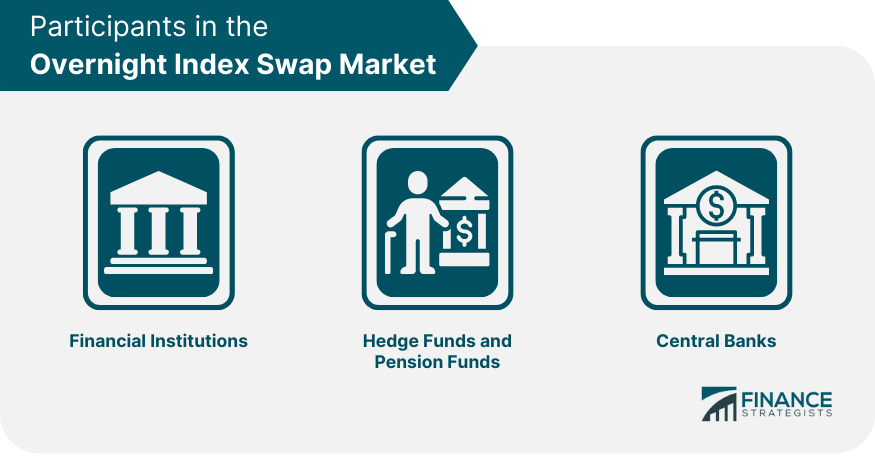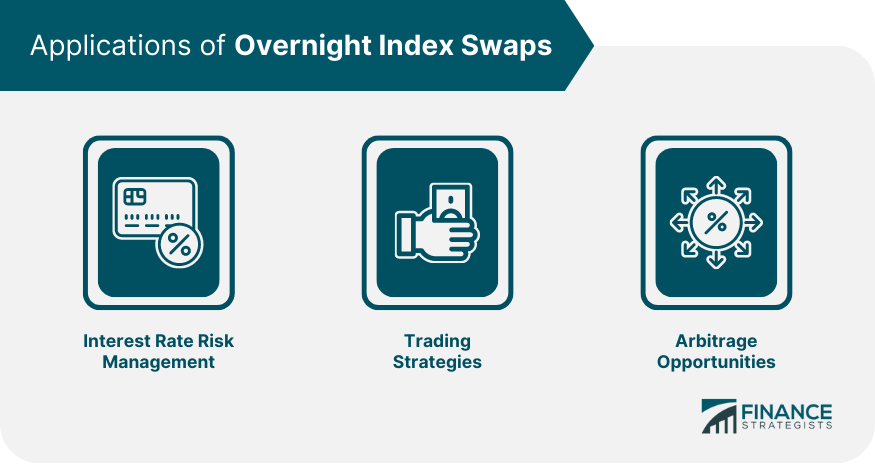An Overnight Index Swap (OIS) is a derivative contract in which two parties agree to exchange, or 'swap', interest rates over a specified period. One party will pay a fixed interest rate and receive a floating interest rate, which is pegged to an overnight rate, such as the Fed funds rate in the US. The 'overnight' refers to the continual resetting of the rate based on the index's daily fluctuations. OIS plays a pivotal role in financial markets as it provides a gauge of market expectations of central bank rates. It can reflect future monetary policy changes and the corresponding market sentiments. As OIS is a risk-free rate, it is used in various contexts including to value and hedge interest rate risk in derivative portfolios, calculate counterparty risk, and make policy decisions. OIS emerged in the early 1990s as a tool for banks to manage fluctuations in short-term interest rates. The increased usage of OIS was fueled by the 2008 financial crisis, which highlighted the need to separate credit risk from interest rate risk in interbank lending. An OIS contract involves two cash flows. One party agrees to pay a predetermined fixed rate of interest on a notional principal amount. In return, they receive a variable interest amount based on the average of the floating overnight rate over the agreed term. The OIS swap rate is determined by the market and represents the average expected overnight rate over the term of the swap. The actual overnight rate is usually computed using a geometric mean, taking into account the compounded interest effect. In financial transactions, OIS is primarily used to hedge interest rate risk. Banks and other financial institutions utilize OIS to lock in a fixed rate, protecting against potential hikes in the overnight rate. Additionally, it serves as a benchmark for pricing other financial instruments. Financial institutions like banks and insurance companies are significant players in the OIS market. They engage in these swaps to manage their interest rate exposure and to speculate on future movements in interest rates. Hedge funds use OIS to hedge against fluctuations in short-term interest rates, which could affect their investment strategies. Pension funds might use OIS to match their assets and liabilities better, reducing their risk exposure. Central Banks are not direct participants but influence the OIS market indirectly. They control the short-term interest rate, which is used as the floating rate in OIS contracts. The OIS curve represents the structure of OIS rates across different maturities, ranging from one day to several years. This curve is crucial in the financial world as it serves as a measure of market expectations for the path of the risk-free interest rate. The OIS curve is built from the market prices of OIS contracts of different maturities. A higher rate for longer maturities indicates the market's expectation of an increase in the overnight rate over time, and vice versa. Unlike other yield curves that incorporate credit risk, the OIS curve reflects only the expected path of future overnight rates. This is because the short-term nature of overnight rates significantly reduces credit risk. The pricing of OIS relies on the principle of no-arbitrage, meaning that the present value of fixed and floating cash flows should be equal at the initiation of the contract. The swap rate in OIS contracts is influenced by factors such as the current overnight rate, expected changes in the rate, the term of the contract, and the demand and supply of OIS in the market. The OIS market acts as a transmission channel for monetary policy as changes in central bank rates directly affect the floating rates in OIS contracts, thereby influencing the behavior of financial institutions. The OIS curve can provide insights into market expectations of future monetary policy changes. Policymakers can use this information to better communicate their intentions and manage market expectations. Central banks can also use the OIS market to implement monetary policy, for instance, by entering into OIS contracts to affect short-term interest rates. Financial institutions use OIS contracts to manage interest rate risk by swapping variable rate payments for fixed-rate payments, thus stabilizing their net interest income. Traders can use OIS contracts to speculate on future changes in overnight rates, thereby generating profits. For example, if a trader expects the overnight rate to increase, they might enter into an OIS contract paying a fixed rate and receiving a floating rate. Arbitrageurs can use OIS to exploit discrepancies between the OIS rate and other interest rates, such as the LIBOR-OIS spread, which represents the credit risk in the interbank lending market. While OIS contracts are generally considered low-risk instruments due to their short-term nature, credit risk can still arise if one party defaults on its obligations. Market risk in OIS arises from unexpected changes in overnight rates, which can cause losses for parties paying the floating rate. Operational risk in OIS includes risks related to contract settlement, documentation, and system failures. Institutions must implement robust risk management processes to mitigate these risks. An Overnight Index Swap is a derivative contract wherein two parties agree to swap interest payments—one pays a fixed rate, and the other pays a rate linked to an overnight index, thus playing a vital role in hedging against interest rate risk and speculation. OIS serves as a gauge of market expectations for central bank rates, reflecting future monetary policy changes and market sentiments. OIS is widely used for interest rate risk management, hedging, valuation of derivative portfolios, and as a benchmark for pricing other financial instruments. The OIS market involves various participants, including financial institutions, hedge funds, pension funds, and central banks. The construction and interpretation of the OIS curve provide valuable insights into market expectations for the risk-free interest rate path, aiding policymakers in communicating their intentions and managing market expectations. Overall, the OIS market and its associated instruments contribute significantly to interest rate risk management, trading strategies, and arbitrage opportunities, while necessitating effective risk management practices to address credit, market, and operational risks. OIS is a sophisticated financial instrument, and its use requires a deep understanding of interest rates and financial markets. Therefore, it is recommended to seek professional advice before engaging in OIS transactions.What Is an Overnight Index Swap?
Mechanics of Overnight Index Swaps
Contract Structure
Calculation of Swap Rate
Use in Financial Transactions
Participants in the Overnight Index Swap Market
Financial Institutions
Hedge Funds and Pension Funds
Central Banks

Understanding the Overnight Index Swap Curve
Definition and Use
Construction and Interpretation
Differences From Other Yield Curves
Pricing and Valuation of Overnight Index Swaps
Basic Principles
Determinants of the Swap Rate
Role of Overnight Index Swaps in Monetary Policy
Transmission Mechanism
Insights Into Market Expectations
Use in Implementing Policy
Applications of Overnight Index Swaps
Interest Rate Risk Management
Trading Strategies
Arbitrage Opportunities

Risk Management in Overnight Index Swaps
Credit Risk
Market Risk
Operational Risk
Final Thoughts
Overnight Index Swap FAQs
An OIS is a financial contract where two parties swap interest rate payments on a specified amount over a set period.
The primary purpose of an OIS is to manage interest rate risk, particularly the risk associated with fluctuations in the overnight lending rate.
The fixed rate is determined at the start of the contract, while the floating rate is the geometric average of the overnight index rate over the contract period.
The main difference lies in the reference rate: OIS uses an overnight rate, while an Interest Rate Swap uses a term rate like LIBOR.
The main risks are counterparty risk (the risk that one party may default on its obligations) and interest rate risk (the risk that the overnight rate could be higher than the fixed rate over the life of the contract).
True Tamplin is a published author, public speaker, CEO of UpDigital, and founder of Finance Strategists.
True is a Certified Educator in Personal Finance (CEPF®), author of The Handy Financial Ratios Guide, a member of the Society for Advancing Business Editing and Writing, contributes to his financial education site, Finance Strategists, and has spoken to various financial communities such as the CFA Institute, as well as university students like his Alma mater, Biola University, where he received a bachelor of science in business and data analytics.
To learn more about True, visit his personal website or view his author profiles on Amazon, Nasdaq and Forbes.











